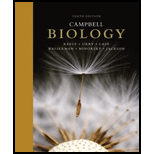
Concept explainers
Sensory receptors transduce stimulus energy and transmit signals to the central nervous system (pp. 1106-1 110)

n The detection of a stimulus precedes sensory transduction, the change in the membrane potential of a sensory receptor in response to a stimulus. The resulting receptor potential controls transmission of action potentials to the CNS, where sensory information is integrated to generate perceptions. The frequency of action potentials in an axon and the number of axons activated determine stimulus strength. The identity of the axon carrying the signal encodes the nature or quality of the stimulus.
n Mechanoreceptors respond to stimuli such as pressure, touch, stretch, motion, and sound. Chemoreceptors detect either total solute concentrations or specific molecules.
To simplify sensory receptor classification, why might it make sense to eliminate nociceptors as a distinct class?
To determine: The reason why it makes sense to classify nociceptors as a distinct class of sensory receptors.
Introduction:
Nociceptors are the sensory receptors that respond to threat stimuli. They are also called pain receptors because they sense any threat to the body and then alarm the brain and spinal cord. They are free nerve endings of a sensory neuron, and they are found in every tissue. When the electric current generated by the neurons reaches above the threshold value, nociceptors get activated and send signals to the central nervous system.
Explanation of Solution
In response to any kind of threat or pain, sensory neurons transmit the signals to interneurons in the spinal cord for the integration of these signals. Substance P is the neurotransmitter that stimulates the interneurons, which carry the signals to the spinal cord. The spinal cord then sends the signals to the brain and the thalamus and the perception of the pain starts. The nociceptors are similar with the other classes of receptors by the kind of stimulus they recognize but are different from the other classes of receptors in the way they recognize the stimulus. Hence, it creates a sense to “eliminate nociceptors as a distinct class of receptors”.
Want to see more full solutions like this?
Chapter 50 Solutions
Campbell Biology (10th Edition)
- How is a protein destined for the Endoplasmic Reticulum (ER), imported into the ER? Be concise.arrow_forwardFind out about the organisations and the movements aimed at the conservation of our natural resources. Eg Chipko movement and Greenpeace. Make a project report on such an organisation.arrow_forwardWhat are biofertilizers and mention the significancearrow_forward
- PCBs and River Otters: Otters in Washington State’s Green-Duwamish River have high levels of polychlorinated biphenyls (PCBs) in their livers. PCBs can bind to the estrogen receptors in animals and disrupt the endocrine system of these otters. The PCBs seem to increase the estrogen to androgen ratio, skewing the ratio toward too much estrogen. How would increased estrogen affect the river otter population? Based on your reading of the materials in this unit, what factors can affect fertility in humans? Explain how each of the factors affecting human fertility that you described can disrupt the human endocrine system to affect reproduction.arrow_forwardOther than oil and alcohol, are there other liquids you could compare to water (that are liquid at room temperature)? How is water unique compared to these other liquids? What follow-up experiment would you like to do, and how would you relate it to your life?arrow_forwardSelection of Traits What adaptations do scavengers have for locating and feeding on prey? What adaptations do predators have for capturing and consuming prey?arrow_forward
- Competition Between Species What natural processes limit populations from growing too large? What are some resources organisms can compete over in their natural habitat?arrow_forwardSpecies Interactions Explain how predators, prey and scavengers interact. Explain whether predators and scavengers are necessary or beneficial for an ecosystem.arrow_forwardmagine that you are conducting research on fruit type and seed dispersal. You submitted a paper to a peer-reviewed journal that addresses the factors that impact fruit type and seed dispersal mechanisms in plants of Central America. The editor of the journal communicates that your paper may be published if you make ‘minor revisions’ to the document. Describe two characteristics that you would expect in seeds that are dispersed by the wind. Contrast this with what you would expect for seeds that are gathered, buried or eaten by animals, and explain why they are different. (Editor’s note: Providing this information in your discussion will help readers to consider the significance of the research).arrow_forward
 Human Biology (MindTap Course List)BiologyISBN:9781305112100Author:Cecie Starr, Beverly McMillanPublisher:Cengage Learning
Human Biology (MindTap Course List)BiologyISBN:9781305112100Author:Cecie Starr, Beverly McMillanPublisher:Cengage Learning Human Physiology: From Cells to Systems (MindTap ...BiologyISBN:9781285866932Author:Lauralee SherwoodPublisher:Cengage Learning
Human Physiology: From Cells to Systems (MindTap ...BiologyISBN:9781285866932Author:Lauralee SherwoodPublisher:Cengage Learning Anatomy & PhysiologyBiologyISBN:9781938168130Author:Kelly A. Young, James A. Wise, Peter DeSaix, Dean H. Kruse, Brandon Poe, Eddie Johnson, Jody E. Johnson, Oksana Korol, J. Gordon Betts, Mark WomblePublisher:OpenStax College
Anatomy & PhysiologyBiologyISBN:9781938168130Author:Kelly A. Young, James A. Wise, Peter DeSaix, Dean H. Kruse, Brandon Poe, Eddie Johnson, Jody E. Johnson, Oksana Korol, J. Gordon Betts, Mark WomblePublisher:OpenStax College Biology 2eBiologyISBN:9781947172517Author:Matthew Douglas, Jung Choi, Mary Ann ClarkPublisher:OpenStax
Biology 2eBiologyISBN:9781947172517Author:Matthew Douglas, Jung Choi, Mary Ann ClarkPublisher:OpenStax Principles Of Radiographic Imaging: An Art And A ...Health & NutritionISBN:9781337711067Author:Richard R. Carlton, Arlene M. Adler, Vesna BalacPublisher:Cengage Learning
Principles Of Radiographic Imaging: An Art And A ...Health & NutritionISBN:9781337711067Author:Richard R. Carlton, Arlene M. Adler, Vesna BalacPublisher:Cengage Learning





